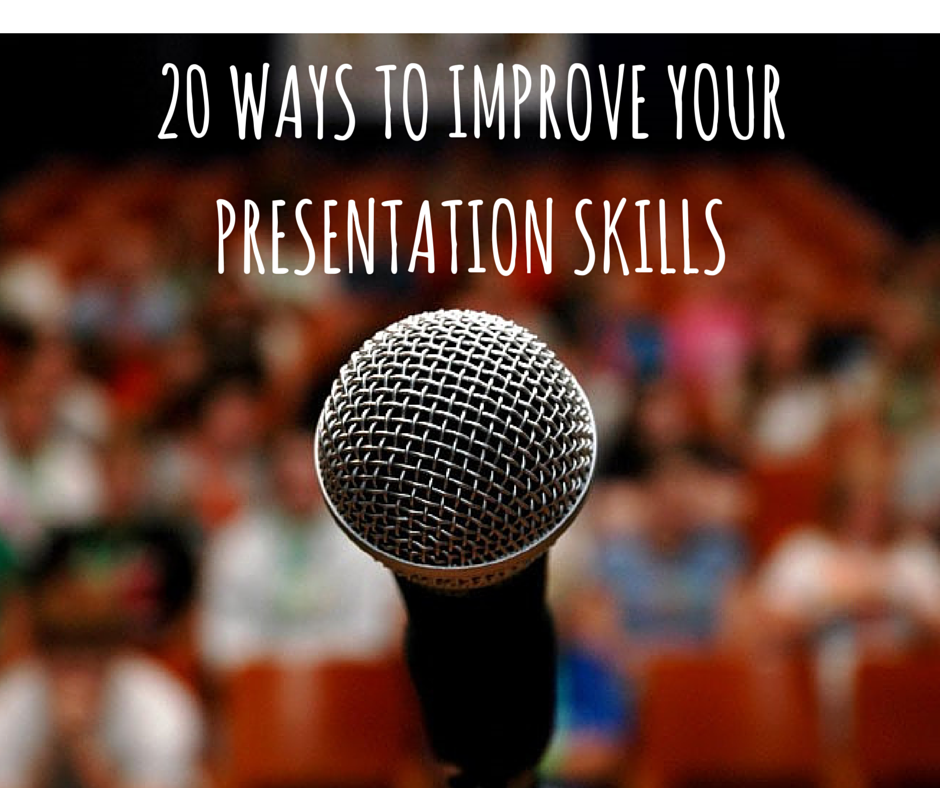I’ve been doing a lot of presenting recently, and I have no problem admitting that it’s tough. For those not born with natural eloquence, public speaking can be remarkably nerve-racking. But I’m getting a lot better!
One of the biggest lessons I’ve learned over the last few years is that to be a great speaker, it’s key to develop a personal speaking style. Since I know I’m not the most eloquent speaker in the world, I make up for it by packing my presentations with enthusiasm, unique/proprietary data, and tons of useful content as well as plenty of dumb jokes.
We can’t all deliver the next Gettysburg Address, but there are lots of small things you can do prior to your presentation that will help calm your nerves and set you up for a better presentation. Here are my 20 best tips to improve your presentation skills.
1. Practice. Naturally, you’ll want to rehearse your presentation multiple times. While it can be difficult for those with packed schedules to spare time to practice, it’s essential if you want to deliver a rousing presentation. I’m famous around the office for staying up late the night before a big presentation, practicing over and over. If you really want to sound great, write out your speech rather than taking chances winging it – if you get nervous about speaking, a script is your best friend.
Try to practice where you’ll be delivering your talk. Some acting strategists suggest rehearsing lines in various positions – standing up, sitting down, with arms open wide, on one leg, while sitting on the toilet, etc. (Okay, that last one may be optional.) The more you mix up your position and setting, the more comfortable you’ll feel with your speech. Do a practice run for a friend or colleague, or try recording your presentation and playing it back to evaluate which areas need work. Listening to recordings of your past talks can clue you in to bad habits you may be unaware of, as well as inspiring the age-old question: “Is that what I really sound like?”
2. Transform Nervous Energy Into Enthusiasm. It may sound strange, but I’ll often down an energy drink and blast hip-hop music in my earphones before presenting. Why? It pumps me up and helps me turn jitters into focused enthusiasm. Studies have shown that an enthusiastic speech can win out over an eloquent one, and since I’m not exactly the Winston Churchill of presenters, I make sure that I’m as enthusiastic and energetic as possible before going on stage. Of course, individuals respond differently to caffeine overload, so know your own body before guzzling those monster energy drinks.
3. Attend Other Presentations. If you’re giving a talk as part of a conference, try to attend some of the earlier talks by other presenters. This shows respect for your fellow presenters while also giving you a chance to feel out the audience. What’s the mood of the crowd? Are folks in the mood to laugh or are they a bit more stiff? Are the presentations more strategic or tactical in nature? Another speaker may also say something that you can play off of later in your own presentation.
4. Arrive Early. It’s always best to allow yourself plenty of time to settle in before your talk. Extra time ensures you won’t be late (even if Google Maps shuts down) and gives you plenty of time to get adapted to your presentation space.
5. Adjust to Your Surroundings. The more adjusted to your environment you are, the more comfortable you’ll feel. Make sure to spend some in the room where you will be delivering your presentation. If possible, practice with the microphone and lighting, make sure you understand the seating, and be aware of any distractions potentially posed by the venue (e.g., a noisy road outside).
5 minutes before my Inbound presentation … gulp
6. Meet and Greet. Do your best to chat with people before your presentation. Talking with audiences makes you seem more likeable and approachable. Ask event attendees questions and take in their responses. They may even give you some inspiration to weave into your talk.
7. Use Positive Visualization. Whether or not you’re a Zen master, know that plenty of studies have proven the effectiveness of positive visualization. When we imagine a positive outcome to a scenario in our mind, it’s more likely to play out the way we envision.
Instead of thinking “I’m going to be terrible out there” and visualizing yourself throwing up mid-presentation, imagine yourself getting tons of laughs while presenting with the enthusiasm of Jimmy Fallon and the poise of Audrey Hepburn (the charm of George Clooney wouldn’t hurt either). Positive thoughts can be incredibly effective – give them a shot.
8. Remember That Most Audiences Are Sympathetic. One of the hardest fears to shake when speaking in public is that the audience is secretly waiting to laugh at your missteps or mistakes. Fortunately, this isn’t the case in the vast majority of presentations.
The audience wants to see you succeed. In fact, many people have a fear of public speaking, so even if the audience seems indifferent, the chances are pretty good that most people listening to your presentation can relate to how nerve-racking it can be. If you start to feel nervous, remind yourself that the audience gets it, and actually wants to see you nail it.
9. Take Deep Breaths. The go-to advice for jitters has truth to it. When we’re nervous, our muscles tighten–you may even catch yourself holding your breath. Instead, go ahead and take those deep breaths to get oxygen to your brain and relax your body.
10. Smile. Smiling increases endorphins, replacing anxiety with calm and making you feel good about your presentation. Smiling also exhibits confidence and enthusiasm to the crowd. Just don’t overdo it – no one enjoys the maniacal clown look.
Don’t be like this guy.
11. Exercise. Exercise earlier in the day prior to your presentation to boost endorphins, which will help alleviate anxiety. Better pre-register for that Zumba class!
12. Work on Your Pauses. When you’re nervous, it’s easy to speed up your speech and end up talking too fast, which in turn causes you to run out of breath, get more nervous, and panic! Ahh!
Don’t be afraid to slow down and use pauses in your speech. Pausing can be used to emphasize certain points and to help your talk feel more conversational. If you feel yourself losing control of your pacing, just take a nice pause and keep cool.
13. Don’t Try to Cover Too Much Material. Yes, your presentations should be full of useful, insightful, and actionable information, but that doesn’t mean you should try to condense a vast and complex topic into a 10-minute presentation.
90 slides in 30 minutes? Only from @larrykim #stateofsearch http://t.co/uttijruots
— Kate Gwozdz (@KateGwozdz) November 17, 2014
Knowing what to include, and what to leave out, is crucial to the success of a good presentation. I’m not suggesting you skimp when it comes to data or including useful slides (some of my webinars have featured 80+ slides), but I am advocating for a rigorous editing process. If it feels too off-topic, or is only marginally relevant to your main points, leave it out. You can always use the excess material in another presentation.
14. Actively Engage The Audience. People love to talk and make their opinions heard, but the nature of presentations can often seem like a one-sided proposition. It doesn’t have to be, though.
Asking the audience what they think, inviting questions, and other means of welcoming audience participation can boost engagement and make attendees feel like a part of a conversation. It also makes you, the presenter, seem much more relatable. Consider starting with a poll or survey. Don’t be put off by unexpected questions – instead, see them as an opportunity to give your audience what they want.
Hopefully this man has a question, and doesn’t just need to go to the bathroom.
15. Be Entertaining. Even if your presentation is packed with useful information, if your delivery bombs, so will your session.
I find that including some jokes and light-hearted slides is a great way to help the audience (and myself) feel more comfortable, especially when presenting them with a great deal of information. However, it’s important to maintain a balance – after all, you’re not performing a stand-up routine, and people didn’t come to your presentation with the sole intention of being entertained. That said, don’t be afraid to inject a little humor into your talk. If you’re not sure about whether a presentation is “too much,” run through it for a couple of friends and ask them to tell it to you straight.
16. Admit You Don’t Have All The Answers. Very few presenters are willing to publicly concede that they don’t actually know everything because they feel it undermines their authority. However, since we all know that nobody can ever know everything about a given topic, admitting so in a presentation can actually improve your credibility.
If someone asks a question that stumps you, it’s okay to admit it. This can also increase your credibility with the audience, as it demonstrates that, no matter how knowledgeable a person might be, we’re all learning, all the time. Nobody expects you to be an omniscient oracle of forbidden knowledge – they just want to learn from you.
17. Use A Power Stance. Practicing confident body language is another way to boost your pre-presentation jitters. When your body is physically demonstrating confidence, your mind will follow suit. While you don’t want to be jutting out your chest in an alpha gorilla pose all afternoon (somebody enjoyed Dawn of the Planet of the Apes a bit too much), studies have shown that using power stances a few minutes before giving a talk (or heading to a big interview) creates a lasting sense of confidence and assurance. Whatever you do, don’t sit–sitting is passive. Standing or walking a bit will help you harness those stomach bats (isn’t that more appropriate than butterflies?). Before you go on stage, strike your best Power Ranger stance and hold your head high!
18. Drink Water. Dry mouth is a common result of anxiety. Prevent cottonmouth blues by staying hydrated and drinking plenty of water before your talk (just don’t forget to hit the bathroom before starting). Keep a bottle of water at arm’s reach while presenting in case you get dry mouth while chatting up a storm. It also provides a solid object to hurl at potential hecklers. (That’ll show ’em.)
19. Join Toastmasters. Toastmaster clubs are groups across the country (and the world) dedicated to helping members improve their public speaking skills. Groups get together during lunch or after work to take turns delivering short talks on a chosen topic. The more you present, the better you’ll be, so consider joining a Toastmaster club to become a top-notch orator. Just don’t forget, it’s BYOB (Bring Your Own Bread).
20. Don’t Fight The Fear. Accept your fear rather than trying to fight it. Getting yourself worked up by wondering if people will notice your nervousness will only intensify your anxiety. Remember, those jitters aren’t all bad – harness that nervous energy and transform it into positive enthusiasm and you’ll be golden. We salute you, O Captain! My Captain!







